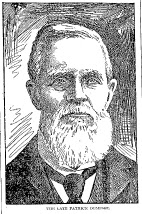 |
| City Directory, 1876 |
His obituary reads like the cause for canonization of a
saint. He was a man of few words, but
when he spoke they had worth. His name
appears as a regular contributor to a number of causes, especially to St.
John’s Hospital where he contributed preserves, sugar, and a child’s
bathtub. He was one of the founding
members who donated heavily to the hospital’s opening. His name appears frequently for sending
floral tributes to funerals of friends, neighbors, and employees. He was so well known to his fellow Irish that
he was asked to be a pall bearer at Father John O’Brien’s funeral. It was said that he was the first of Lowell’s
Irish immigrants to have earned considerable wealth.
His financial status enabled him to buy considerable real
estate, centering in the Acre. He bought
an estate on Salem Street where he made his home for his 2 wives and a dozen
children. Though he could have moved
into any of the newer neighborhoods, he chose to remain in the Acre. The property attached to his home was called
Dempsey’s Place and was a heavily crowded series of tenements typically rented
to other Irish. He also bought property
in Salem, Mass where he had a summer home, and his family often made trips
across the country. His son, however,
would move into a great home on Andover Street following his father’s death.
At one point he was sued by a neighbor for erecting a high
stockade fence which she argued caused an unhealthy lack of light resulting in
sickness and even a death in her home.
And then there was the case where Mr. Dempsey sued the Congregational
Church on Merrimack Street for water damage from the church’s gutters that
flooded Dempsey’s liquor business on Lowell (Market) Street. He
made it a point to stay out of politics, but could be quite outspoken if there
was a possibility of his property being rezoned or of taxes status being
altered.
 |
| Lowell Cultural Resource Inventory |
So where did his wealth come from? Alcohol.
Born in County Wicklow, Patrick Dempsey came to America and began work
in a print and dye factory. He moved
from place to place until landing in Lowell.
He rented a basement on Lowell Street where he brewed root beer. He was so successful that he branched into
beer and other spirits. Within a few
years he became the leading saloon owner not only in Lowell, but in the entire state. He turned brewing into big business opening
shops and bars across the city and dealing sprits across the state. And that brings us to “the rum riot.”
The 19th century was a period of great change. The temperance movement had begun in the
early part of the century and made advancements throughout the decades. Across the country laws were being passed on
restrictions of who, where, and how much alcohol could be brewed. Massachusetts was no exception. The state sent sheriffs out to seize barrels
of the stuff during a particularly strict period of prohibition in 1870s. When they came to Lowell, Dempsey, since he
was the largest, was also the first establishment to be visited. As soon as word got out that they were at
Dempsey’s a crowd gathered from amongst “the lower strata of the
population.” “The roughs collected,
ready for a row or fight.” The crowds
began stoning the officers. One of the
roughians used a hoe to strike an officer.
The officer’s gun fired during the melee hitting one of the crowd. The man who struck the officer, Pender, was
arrested and held for bail, but his case was quickly moved since his family was
known to have small pox. The next day
the crowd returned, but was informed of undercover constables in the crowd who
were ready to stop any trouble before it erupted. The establishments that were visited read
like a list of Lowell’s Irish who’s who.
There was Lynch, Cummiskey, and Collins.
It goes on. The constables came
back yet a third day when the crowds started up again. This time the constables came back in full
force. They were supported by women and
girls waving handkerchiefs and shouting, “Huzza,” cheering on the police. Over the 3 days, hundreds of barrels of alcohol
were confiscated and placed under guard until they could be shipped to
Boston. There were fears that the crowds
might attempt to remove the spirits.
 |
| Lowell Sun, 1902 |















